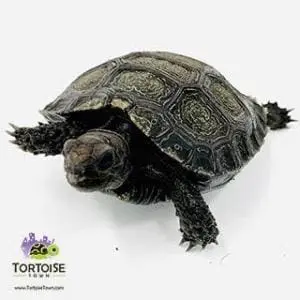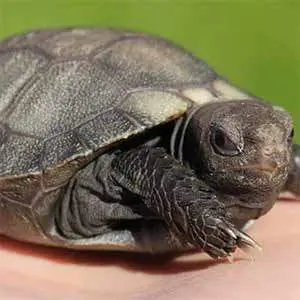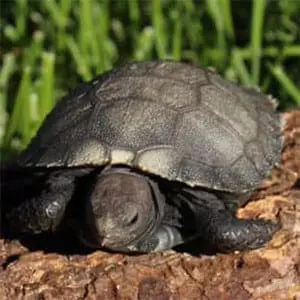Burmese Mountain Tortoise Care
Burmese Black Tortoise Manouria emys phayrei
Before purchasing a burmese tortoise for sale, or burmese mountain tortoise for sale, please read and research proper care for your new pet burmese brown mountain tortoise for sale.
The Manouria emys is considered to be the 4th largest tortoise in the world and is sometimes called 6 legged tortoise because of the very large spurs on its hind legs.
Manouria phyrei may be twice as large as the Manouria emys. The Manouria emys is the species more commonly kept in the USA and can grow to 24 inches/ 50 centimeters and weigh 20 kilograms or up to 50 lbs. Its color may vary from brown to black.
Manouria emys originate in South East Asia from India, Burma, Sumatra, Thailand to Borneo and live mainly in the moist tropical forest regions. General Husbandry Requirements: All tortoises have very specific husbandry requirements, and they will suffer from illness and stress-related disorders if their needs are not met. A burmese brown mountain tortoise or burmese black mountain tortoise cannot tolerate hot, dry weather and need a shady area to escape to with moderate temperatures from 13°C (55°F) up t o 29°C (85°F) with high humidity.
They will also require a water wallow. Activity tends to be early morning and during the late afternoon, early evening. General Housing: Indoors: Any indoor tortoise enclosure should be as big as possible for hatchlings or young juveniles. An open-topped, deep-sided tortoise table is essential for this species or an old bookcase or chest of drawers laid on their backs, are cheap, spacious and environmentally friendly. The tortoise should be kept in a well ventilated room, out of draughts and away from direct sunlight.
Use small rocks, flattish stones, slate and upturned flower pots to add interest, break up the line of sight and also help keep the tortoise’s nails and beak trim. Adults will require an insulated shed, garage or outbuilding to live in with access to an outside enclosure. From October through to March the burmese mountain tortoise will live inside. A deep substrate of Graze On, Just Grass or Readi Grass which can be purchased from horse food suppliers should be provided. Fallen non-poisonous leaves can be mixed in with the grass substrate as Burmese browns love to bury in them. N.B. Hemp has sharp particles which can easily cause serious damage to tortoises and it can sometimes prove to be fatal especially if ingested and as Burmese Brown such is not recommended for use as a substrate.
The large combination UVB and heat lamps are ideal but background heat with tubular greenhouse heaters might be required in colder weather.
Outdoors: Try to make the tortoise’s outdoor enclosure as big and as interesting as possible. Tortoises love to explore and hide so ensure they have several shady ‘hides’ they can retreat to when the sun gets too hot or the rain gets too heavy ! They also love to climb so try to provide rocky mounds too. Plant the enclosure with a variety of tortoise-friendly weeds and flowers, with shrubs. Burmese Browns also need a waterproof, dry, heated, animal-proof shelter to sleep in (an insulated shed or Wendy house is generally preferred). Fresh water should always be available in a water wallow.
Ensure perimeter fences are escape proof ideally made of close board wood or similar and relatively high as Burmese Browns are good climbers. Hatchling Housing & Hatchling Care: Baby tortoises are entirely self-sufficient upon hatching. Their diet and husbandry requirements are the same as adults, although some extra care is required due to their small size and growth requirements. Indoor accommodation will need to be provided for the cooler Spring and Autumn months and secure outdoor accommodation. Hatchlings should be outside as much as possible, weather permitting, as the UVB light emitted from the sun, even on a cloudy day, is far superior to that of any lamp.
If the daytime temperature is over 18°C (65°C) it is warm enough f or even very young tortoises to be outdoors, and they can stay out 24/7 once the overnight temperatures exceed about 10°C (50°F). Hatchlings are best housed in table top arrangements both indoor and out for the first few years of life; although they do grow very quickly. A 50/50 mix of play sand and sterilised topsoil can be used, or alternatively Readi Grass, Graze On or Just Grass mixed with leaves. The substrate will need to be sprayed regularly with water to help with humidity requirements.
The bedroom area will need a small sponge attached to the inside roof kept damp to increase humidity. A water dish large enough for the hatchlings to enter and sit in should be provided as a water wallow. Fresh water should be provided on a daily basis. Diet and Feeding: This is essentially the same as for an adult tortoise – please see the ‘Feeding and Dietary Supplement’ section. A combination of the correct diet, not overfeeding, access to UVB light and correct supplementation is required for healthy growth.
Tortoises are natural grazers, and by offering two smaller amounts morning and afternoon, this will mimic conditions in the wild. A light sprinkling of Nutrobal should be used on the food daily – if the leaves are wet the powder will stick better, and the hatchling will also take up more water. Cuttlefish bone in the enclosure will be appreciated, and although not the best source of calcium, it is a good way of keeping the beak trimmed.
Dehydration is a real danger for hatchlings, particularly when kept indoors under lights. The tortoise will need to be bathed on a daily basis. This is not to keep it clean, but to encourage it to drink. This should be done using a container deep enough so the tortoise can’t climb out – margarine or ice cream tubs are ideal. Fill with tepid water, only deep enough to reach up to chin level or where the top of the shell meets the bottom. Place the tub in a warm area near the light so the water doesn’t get too cold, and leave the hatchling in there for 15 to 20 minutes.
It will normally have a drink each time, stretching the neck out with the head under the water, and if the throat is watched carefully, the tortoise can be seen swallowing the water! Fresh water should always be available at all times in a shallow dish. In the wild, hatchling tortoises would spend a lot of their time hidden away from predators: if they are not allowed to hide away, this will increase stress levels for them. Ensure that the substrate is deep enough to allow burying (this will also help with dehydration as it allows them to thermoregulate) and that they have shady areas to hide, as well as basking places. Cleaning: The substrate should be spot checked regularly and any faeces and damp patches removed.
Ideally, the substrate should be removed every 6 weeks totally from the table top or tortoise house and sooner if very soiled. Emys tend to relieve themselves in the corner of their house and then sit in it and it usually in the same corner. A disinfectant such as F10, Virkon – S or Tamodine should be used to clean the table or floor thoroughly. Juvenile Housing: As the hatchling begins to grow, allow it more room to explore — boredom will make the tortoise unhappy. Be warned that tortoises are very good climbers, so keep plants/bridges etc away from the perimeters of the enclosure or it will use them as a ladder to escape. Not only will wire lids protect it from predators, but they will help to keep it in too.
Enclosures need to keep your pet Mountain tortoise for sale happy and safe!
The enclosure needs to have high solid sides – if the tortoise can see through a barrier, it will try to get through it, which will cause unnecessary stress. Juvenile tortoises will become stressed if they get too hot so plenty of shady places must be provided. Adult Housing: An adult will naturally need as much of the garden as can be allowed, variety and space are paramount for the tortoise to enjoy the rest of his long life. Secure all boundaries, as they have very strong legs and can easily dig their way out or climb over. An insulated shed with a simple basking lamp and access to the garden is ideal for a Burmese Brown tortoise. Heating and Lighting: Ultra violet light (UVB range) is vital for all tortoises, as it plays a huge role in the production of vitamin D3 which is essential for the correct formation of bony tissue. Natural sunlight is THE best source of UVB, so as much access to this as possible is extremely important. However, it is not always possible to have the tortoise outdoors all through the year so a high quality UVB combined heat/light bulb or a full spectrum fluorescent tube will be needed.
UVB is key to a healthy Burmese mountain tortoise for sale
A full spectrum tube needs to be as close to the tortoise, without actually touching it, as possible, as UVB diminishes the further away the tube gets. These tubes do not emit heat so a separate basking lamp would also be necessary. Most fluorescent tubes have a life-span of around 6 months (the exception being the 10.0 tubes, which can last for up to a year). It isn’t necessary to buy a special reptile basking lamp: a simple 40W or 60W spot bulb will be fine. Please ensure that all lights are securely fixed to reduce the risk of fire. The alternative is a self-ballasted mercury vapor lamp, an ‘all-in-one’ heat and UVB bulb. These need to be used with a ceramic bulb holder designed for the correct wattage, and they also have a high UVB output.
Burmese Browns tend not to bask for as long as other species. After they have eaten they bury down in the substrate for the rest of the day. The desired temperature can be achieved by raising or lowering the height of the lamp. Whichever method is chosen, aim for between 28°C (8 2°F) – 30°C (86°F) under the heat source, making sure it is positioned at one end of the enclosure. This will allow the tortoise to maintain its own temperature gradient, as it can move into the cooler end at around 20°C (68°F) when it needs to. Burmes e Brown tortoises don’t need any additional night time heat, unless the temperature will fall below 10C (50°F), as it is actually beneficial for them to feel the coolness of night approaching; it’s very natural and normal to them. To prevent the temperatures falling too low background heat can be provided by either a convector heater or tubular heater connected to a thermostat.
Burmese Mountain Tortoise for sale – Humidity:
The Burmese Brown tortoise requires a degree of humidity to thrive. Levels should be kept between 60%-100%.
Burmese mountain tortoise and hibernation:
Masnouria Emys do NOT hibernate and will need to be kept warm during the cooler months. Breeding: The male Emys is very vocal during courtship nodding his head enthusiastically and extending his neck he trails the female before mounting her. Female Emys, unlike other species, build a nest on the ground by sweeping leaf litter and debris into a pile with their front legs. She then lays up to 50 eggs and piles vegetation on top before guarding her nest. She may add more vegetation and lay on top of the nest to protect her eggs. Guarding usually lasts for the first few days only.
Burmese Mountain Tortoise for sale, Feeding and Dietary Supplementation:
Emys are basically vegetarian feeding on a wide variety of leafy weeds plus some grasses, good quality lettuce such as Romaine, spring greens, cauliflower (cooked) broccoli, mushrooms, and small amounts of fruit. Very occasional amounts of animal protein may be given as in their natural environment emys would almost certainly feed on worms, carrion etc. Dandelion – flowers and leaves Landcress Grape leaves Clover Plantain Cats ears Sow thistle Lavatera – flowers and leaves Bittercress Pansies/viola Dead nettle Nasturtiums Vetch Welsh Poppies Mulberry leaves Rose petals Hibiscus – flowers and leaves Bindweed (a firm favourite) Mushrooms Honeysuckle – flowers only Wild strawberries Hollyhocks Fruit Campanula (another favourite) Cactus Evening Primrose broccoli Wild Mallow Cauliflower Rough Hawkbit Yams Squashes
Burmese Mountain Tortoise Foods to avoid:
DO NOT use any commercial tortoise pellets: they are very high in protein, addictive and don’t resemble anything the tortoise would eat in the wild! SPINACH: Spinach and chard are high in oxalates, which bind with calcium to give insoluble calcium oxalate and thus interfere with calcium absorption. ICEBERG LETTUCE has no nutritional value at all and is almost entirely water. Mineral and Vitamin Supplements UVB levels in the tortoise’s natural habitat are vastly higher than anything we experience in the UK, so its food must be lightly dusted with a vitamin and mineral supplement which contains vitamin D3 and calcium, such as Nutrobal.
Supplements are important for your new pet Burmese mountain tortoise for sale
Hatchling and Juvenile tortoises In Northern climates a mineral and vitamin supplement such as Nutrobal or Reptavite should be offered to all growing tortoises on a daily basis for the first 3-4 years of life and after this it can be offered three times a week. This should be lightly sprinkled on the tortoise’s food. NB. If the tortoise is kept outside of the UK, where the climate is similar to its natural habitat, and it is maintained outdoors where it can synthesise its D3 requirements from the UVB component of solar radiation, then the frequency of additional supplementation of D3 can be reduced. Adult tortoises Mineral and vitamin supplementation for adult tortoises in the form of Arkvits or Nutrobal can be lightly sprinkled daily on to the food. Tortoises of all ages.
In addition, all tortoises, whatever their age, will benefit by some calcium supplementation in the form of limestone flour (or another form of pure calcium carbonate) and this can be sprinkled lightly on to the daily feed or on the ground. Limestone flour is available from most equestrian stockists and is recommended due to its high calcium content and the fact that it is easily digested. Cuttlefish, which contains calcium, should be made available at all times, and although it is not as easily digested as limestone flour, it is a good way of keeping the beak trimmed. When providing mineral and vitamin supplementation it is important that the manufacturer’s instructions be followed to avoid the possibility of over dosing
Remember when searching for any tortoises for sale, including a new baby tortoise for sale, tortoise town is your source for the best tortoise for sale , baby tortoises for sale , baby turtles for sale, and adult turtles for sale of any turtle storeanywhere including a huge aquatic turtles for salesection. If you are interested in tortoise care, please visit our care section.
Over 25 Species of captive bred tortoises for sale
Other species of tortoise for sale offered here include giant tortoises like the Aldabra tortoise for sale, Sulcata tortoise for sale, Burmese mountain tortoise and more. Medium size species include the leopard tortoise, red-footed tortoise, yellow foot tortoise, mountain tortoise, Burmese star tortoise for sale and the giant leopard tortoise. Small tortoise for sale includes Hermann’s tortoise, Greek Tortoise, Indian Star tortoise, Pancake Tortoise, Russian tortoise and the Egyptian tortoise. Above all, we’ve got the widest selection of tortoise for sale in the USA, including baby tortoise, juveniles and adult tortoises for sale.



